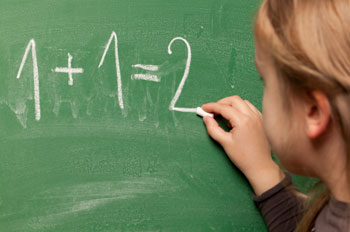Geometry Help: Working with Circles
In middle school geometry, you're typically asked to do two things with circles: find their area and calculate their circumference. In high school, you'll be given more challenging tasks, like measuring inscribed angles and drawing tangents. Read on for more information about working with circles!

Understanding Circles
A circle is a closed curve where all points are the same distance from the center. All circles measure 360 degrees. Every circle has a radius, which is the distance from the center to the outside edge, and it's usually represented in equations as r. The diameter, which is represented as d, is a straight line that passes through the circle's center and extends to opposite sides of the circle. It's twice the circle's radius (d = 2r). Another important value to know when you're working with circles is pi, which is approximately equal to 3.14.
Circumference
Circumference is the length of the outside edge of a circle. The formula for circumference is C = 2(pi)r. If you know the circle's radius, you can multiply that value by two and 3.14. If you only know the circle's diameter, then divide it by two and multiply that number by the other two values.
Area
A circle's area is the amount of 2-dimensional space enclosed by its outer edge. You can calculate the area of a circle using the formula A = (pi)r^2. First, square the radius (multiply it by itself). Then, multiply the value of r^2 by 3.14 to get the area.
Advanced Geometry
If you're in high school, you'll need to know more about circles than just how to find area and circumference. Keep reading to learn about angles and tangents.
Inscribed Angles
A chord is a line that goes from one point on the edge a circle to another, but doesn't necessarily pass through the center of the circle. Two chords that share a single endpoint form an inscribed angle. If the two points where the inscribed angle's sides intersect the circle can be connected to form a diameter, then the inscribed angle measures 90 degrees.
Central Angles
A central angle has its vertex (point where two lines intersect) at the center of the circle, instead of on the edge. If the two sides of a central angle and an inscribed angle intersect the edge of the circle in the same two places, then the measure of the inscribed angle is equal to half the measure of the central angle.
Arcs and Tangents
An arc is a segment of the outside edge of a circle. Its measure is equal to the measure of the central angle that results if you draw two radii from the arc's endpoints to the center of the circle. A tangent is a line drawn perpendicular to a radius, and which passes through the point where the radius intersects with the circle.
Other Articles You May Be Interested In
-
Not Your Father's Algebra As 45 States Look to Math Reform

One plus one will always equal two...but just how students are taught math is going to change. Nearly every state in the country has adopted the Common Core Standards; for math, this means new and more in-depth approaches to teaching the subject. Have we seen the last of traditional algebra and geometry classes?
-
The Pythagorean Theorem: Almost As Easy As ABC

One of the most useful and widely used rules in mathematics is the Pythagorean theorem. Your child's mastery of this theorem is critical to success in geometry. One helpful method for understanding and remembering a rule like the Pythagorean theorem is to fully explore its meaning and history.
We Found 7 Tutors You Might Be Interested In
Huntington Learning

- What Huntington Learning offers:
- Online and in-center tutoring
- One on one tutoring
- Every Huntington tutor is certified and trained extensively on the most effective teaching methods
K12

- What K12 offers:
- Online tutoring
- Has a strong and effective partnership with public and private schools
- AdvancED-accredited corporation meeting the highest standards of educational management
Kaplan Kids

- What Kaplan Kids offers:
- Online tutoring
- Customized learning plans
- Real-Time Progress Reports track your child's progress
Kumon

- What Kumon offers:
- In-center tutoring
- Individualized programs for your child
- Helps your child develop the skills and study habits needed to improve their academic performance
Sylvan Learning

- What Sylvan Learning offers:
- Online and in-center tutoring
- Sylvan tutors are certified teachers who provide personalized instruction
- Regular assessment and progress reports
Tutor Doctor

- What Tutor Doctor offers:
- In-Home tutoring
- One on one attention by the tutor
- Develops personlized programs by working with your child's existing homework
TutorVista

- What TutorVista offers:
- Online tutoring
- Student works one-on-one with a professional tutor
- Using the virtual whiteboard workspace to share problems, solutions and explanations